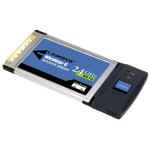PCMCIA stands for Personal Computer Memory Card International Association. PCMCIA standards were developed for small, credit card-sized devices, called PC Cards. Though PCMCIA cards (PC Cards) were originally developed for use with Notebook computers, the same are being extensively used in other devices also.
Types of PC Cards:
There are 3 types of PC Cards.
1. Type-I PC Cards are typically used for memory devices such as RAM, Flash, and SRAM cards.
2. Type II PC Cards are typically used for I/O devices such as modems, and LAN cards.
3. Type III PC Cards are used for devices that consist of thicker components, such as rotating mass storage devices.
| Property | Value |
| Physical Interface Connector | 68 pins |
| Length | 85.6 mm |
| Width | 54.0 mm |
| Thickness | |
| Type-I | 3.3 mm |
| Type-II | 5.0 mm |
| Type-III | 10.5 mm |
| Back-end I/O Connector | Depends on the functionality of the PC Card |
PCMCIA Card (PC Card) slots:
Just like PC Cards, PCMCIA slots also come in three sizes:
Type I slot: Holds up to one Type I card
Type II slot: Holds up to one Type II card or two Type I cards
Type III slot: Holds up to one Type III card or a Type I and Type II card.
Advantages of PC Cards:
Several advantages offered by PC cards are as given below:
1. CardBus: CardBus allows PC Cards and hosts to use 32-bit bus mastering.
2. DMA: The Standard allows cards to utilize Direct Memory Access technology directly in the hardware when matched with a corresponding host system.
3. eXecute In Place (XIP): XIP allows operating system and application software to run directly from the PC Card. This in turn improves performance, and eliminates the need for large amounts of system RAM.
4. Low Voltage Operation: The Standard enables 3.3V as well as 5V operation.
6. Plug and Play: PC Cards can be inserted or removed while the system is powered-on.
7. Power Management: The Standard provides a means to interface to APM (Advanced Power Management).
PC Card Uses:
Some of the frequently used PC Card types include the following:
A wireless LAN serves the same functionality of a traditional LAN card, but operates without being physically wired to a network device. It enables a mobile user to connect to a local area network (LAN) through a wireless connection. IEEE 802.11a, 802.11b, and 802.11g specify the technologies for wireless LANs.

Linksys 802.11b/g Wireless PC Card
A wireless LAN card is shown in the figure above. Typical specifications for the same are given below:
Connection Type: Wireless
Connector: PCMCIA
Supported Wireless Standards: 802.11b, 802.11g
Supported Operating Systems: Windows, 98, ME, 2000, XP
Download practice tests:
Download Sim-Ex™ Practice Exams for A+ Core 1
Download Sim-Ex™ Practice Exams for A+ Core 2
Related practice tests:
Sim-Ex™ Practice Exams for Network+
Sim-Ex™ Practice Exams for Server+
Sim-Ex™ Practice Exams for Security+
Disclaimer: Simulationexams.com is not affiliated with any certification vendor, and Sim-Ex™ Practice Exams are written independently by SimulationExams.com and not affiliated or authorized by respective certification providers. Sim-Ex™ is a trade mark of SimulationExams.com or entity representing Simulationexams.com.A+™,Network+™,Security+™,Server+™ are trademark of CompTIA® organization.